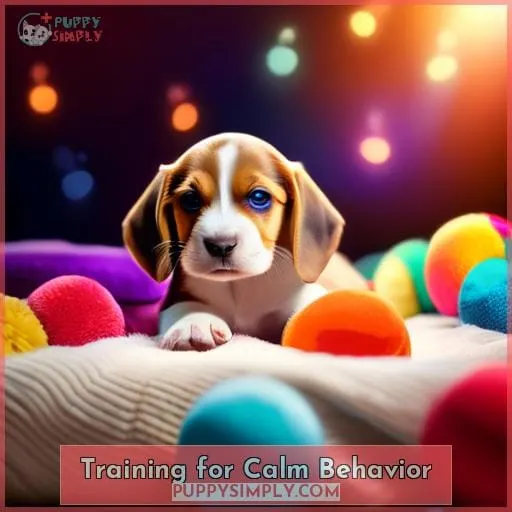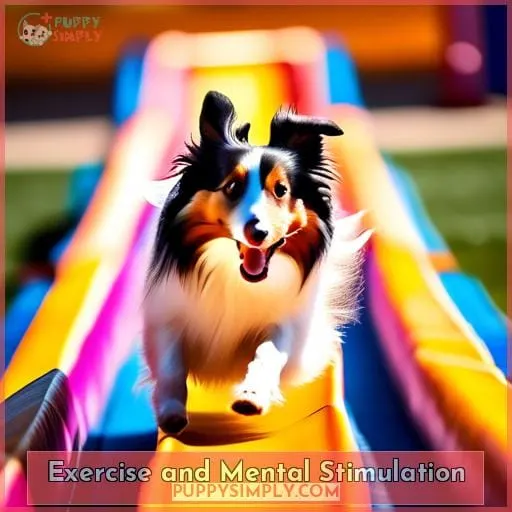This site is supported by our readers. We may earn a commission, at no cost to you, if you purchase through links.
 Navigating the whirlwind of a beagle’s boundless energy can feel like trying to calm a tempest with a whisper.
Navigating the whirlwind of a beagle’s boundless energy can feel like trying to calm a tempest with a whisper.
With the right blend of training and tips, you can channel their zest into tranquility.
Whether they’re bouncing off the walls or treating your home like a racetrack, understanding how to get beagles to calm down is key to harmonizing their high spirits with your need for serenity.
To get beagles to calm down, engaging them in regular, vigorous exercise and providing mental stimulation through play and training are effective strategies.
Table Of Contents
- Key Takeaways
- Understanding Beagle Hyperactivity
- Managing Puppy Energy
- Training for Calm Behavior
- Exercise and Mental Stimulation
- Addressing Overexcitement
- Health and Nutrition
- Frequently Asked Questions (FAQs)
- How can I tell if my Beagle’s hyperactivity is due to a medical condition rather than just high energy or excitement?
- Are there specific breeds that Beagles get along with better for playdates to help manage their hyperactivity?
- What are the signs that my Beagle is not just hyper but also stressed or anxious, and how do I address this?
- Can certain foods or diet changes help in reducing my Beagle’s hyperactivity, and what should I avoid or include?
- How do I manage my Beagle’s hyperactivity in situations where physical exercise isn’t possible, such as during bad weather or if I’m unwell?
- Conclusion
Key Takeaways
- Engage Beagle puppies in structured playtime and indoor/outdoor activities to tire them out physically and mentally, which helps manage their high energy levels.
- Teach Beagles basic commands like ‘sit’ and ‘stay’ for discipline and mental stimulation, and use reward-based training for positive reinforcement.
- Dedicate at least 60 to 90 minutes daily to exercise and mental stimulation through outdoor activities like hiking and indoor games like puzzle toys to maintain their physical and mental health.
- Address overexcitement by discouraging jumping with consistent commands and redirecting their energy toward toys or tasks, while reinforcing calm behavior with calming verbal cues and rewards.
Understanding Beagle Hyperactivity
If you’re noticing your Beagle’s boundless energy and wondering if it’s normal, rest assured that hyperactivity is a common trait, especially in younger dogs.
As your Beagle grows, you’ll likely see a shift in their energy levels, with a notable decrease as they reach adulthood.
It’s important to differentiate between typical youthful zest and the rare condition of true hyperkinesis, which would require a vet’s diagnosis and possibly treatment.
Hyperness Levels by Age
One’s Beagle’s level of hyperactivity can significantly vary as they age, and understanding these changes is crucial for providing the right care and training. During hyper puppyhood, your Beagle may seem like a bundle of endless energy, especially from 4 to 12 months when they’re very hyper.
As they reach adolescent antics between 12 to 24 months, you’ll notice a turning point where their energy starts to become more manageable. Mature mellowness sets in after 24 months, with adult Beagles still enjoying activity but in a more controlled manner.
Senior serenity graces Beagles over 8 years old, who often display slight to no hyperactivity and appreciate familiar comforts.
Managing energy at each stage is key. For the hyperactive periods, calming beds for anxious dogs, such as a donut dog bed or memory foam dog bed, can offer a retreat. For durability, an indestructible dog bed might be a wise choice. To address dog anxiety, consider interactive play and mental stimulation to help your Beagle settle down.
Recognizing True Hyperkinesis
While it’s common for Beagles to exhibit high energy levels, if you’re noticing that your dog’s activity is excessive and accompanied by symptoms like rapid heart rate, poor trainability, and extreme sensitivity to stimuli, it’s important to consider that they might be suffering from hyperkinesis, a rare but serious condition.
Identifying behavioral triggers and pursuing diagnostic testing are crucial steps.
Effective symptom management may involve medication options and lifestyle adjustments, tailored to reduce anxiety and improve your beagle’s quality of life through focused training.
Managing Puppy Energy
When managing your Beagle puppy’s energy, it’s essential to provide structured playtime and ensure they get adequate sleep.
You’ll want to engage them in activities that tire them out physically and mentally, which can lead to a more peaceful home environment.
Structured Playtime
Transitioning from understanding the hyperactivity of Beagles, it’s crucial to implement structured playtime to effectively manage your puppy’s energy.
Indoor activities like hide-and-seek with treats and outdoor games such as fetch can provide enrichment exercises.
Regular Beagle exercise with these Beagle toys ensures a well-balanced pup.
Adequate Sleep Importance
Every Beagle puppy needs a significant amount of sleep; you’ll find they require up to 18-20 hours a day to support their rapid growth and development. This rest is crucial in managing their hyperactivity and easing separation or travel anxiety.
Introducing a comfort cuddler buddy can also help, emphasizing the importance of relaxation alongside their energetic play.
Training for Calm Behavior
Training your Beagle to embrace calm behavior is essential for a harmonious home. You’ll want to start by teaching them basic commands like ‘sit’ and ‘stay’, which not only instill discipline but also provide mental stimulation.
Consistently reinforcing these boundaries shows your Beagle what’s expected, helping to channel their energy into positive behaviors.
Basic Commands
After managing your puppy’s energy through structured playtime and ensuring they get adequate sleep, it’s crucial to start teaching them basic commands to foster calm behavior.
You’ll find that using simple, clear instructions like sit, stay, and come can significantly enhance your Beagle’s obedience and overall demeanor.
Introduce advanced commands gradually, employing reward-based training and positive reinforcement.
Distraction techniques are key in handling distractions and curbing any unwanted Beagle biting.
Consistent Boundaries
Building on your Beagle’s understanding of basic commands, it’s crucial to establish consistent boundaries to foster calm behavior. You’ll need to set clear rules and expectations for your dog’s conduct within the home and during walks, ensuring they understand the limits of acceptable behavior.
This consistency helps your Beagle learn self-control and respect for your guidance, contributing to a more harmonious relationship between you and your pet.
- Setting Limits: Clearly define where your Beagle can and can’t go in the house, like designating specific no-entry zones.
- Establishing Rules: Implement a predictable routine for meals, walks, and bedtime to provide a sense of security and stability.
- Firm Guidance: Use commands consistently, and consider aids like a pheromone diffuser or hemp oil for a calming environment.
Exercise and Mental Stimulation
To help your Beagle find peace and improve their behavior, focusing on daily exercise is key.
These activities not only tire them out physically but also provide the mental stimulation they crave, making them more relaxed and manageable.
Engaging them with interactive games and toys is also crucial.
Daily Exercise Needs
To seamlessly transition from the importance of training for calm behavior, it’s crucial to recognize that a significant portion of your Beagle’s energy can be effectively managed through daily exercise and mental stimulation.
You’ll find that dedicating at least 60 to 90 minutes each day to these activities not only keeps them physically fit but also significantly contributes to a more tranquil home environment.
| Activity Type | Benefits | Examples |
|---|---|---|
| Outdoor Adventures | Physical fitness, Social interactions | Hiking, Dog parks |
| Indoor Activities | Safety, Mental challenges | Scent and sound games, Heartbeat puppy toy |
| Enrichment Games | Mental stimulation, Sound anxiety relief | Puzzle feeders, Interactive toys |
Interactive Games and Toys
Transitioning from the importance of daily exercise for Beagles, it’s crucial to also focus on their need for mental stimulation, which can be effectively addressed through interactive games and toys.
- Puzzle Toys: Challenge their problem-solving skills.
- Scent Games: Utilize their keen sense of smell.
- Interactive Feeders: Turn mealtime into a brain game.
- Tug-of-War: Provides physical and mental engagement.
Addressing Overexcitement
If your Beagle’s excitement is leading to jumping and overenthusiasm, it’s important to address this behavior calmly and consistently.
You can discourage jumping by turning your back and only giving attention when all four paws are on the ground.
Introducing calming verbal cues and rewarding your Beagle when they respond can also help them learn to settle down and enjoy a more peaceful state of mind.
Discouraging Jumping
In addressing overexcitement, one effective strategy for calming your Beagle down is to discourage jumping by using consistent, clear commands.
| Strategy | How to Implement | Benefit |
|---|---|---|
| Redirecting jumping behavior | Offer a toy or task as an alternative | Channels energy into positive actions |
| Consistency reinforcement | Use the same command every time | Builds understanding and routine |
| Positive redirection | Reward calm behavior with treats | Encourages desired behavior |
Calming Verbal Cues
Use calming verbal cues to address your Beagle’s overexcitement by speaking in a gentle, soothing tone, which can help signal to your dog that it’s time to settle down.
- Reinforcing Relaxation with peaceful vocalizations encourages a serene environment.
- Soothing Commands, like easy or settle, promote tranquility.
- Tranquil Communication through relaxing instructions fosters a calm demeanor, ensuring safety and understanding.
Health and Nutrition
Your Beagle’s health and nutrition play a crucial role in managing their energy levels. A well-balanced diet, possibly supplemented with nutrients like L-theanine, GABA, and valerian root, may help soothe their excitement.
It’s important to feed them high-quality food that meets their life stage requirements.
Importance of Diet
Frequently, managing your Beagle’s excitement from playtime transitions smoothly into considering their dietary needs, as you’ll often find that a well-balanced diet contributes significantly to their overall energy levels and behavior.
Balanced nutrition is crucial for your Beagle, encompassing all their nutritional requirements through a mix of high-quality proteins, healthy fats, vitamins, and minerals.
Dietary adjustments, such as incorporating healthy treats and establishing consistent mealtime routines, can play a pivotal role in maintaining their health and vitality.
It’s essential to tailor their diet to their specific life stage and energy needs, ensuring they receive all the necessary nutrients for optimal well-being.
Potential Supplements
Following the discussion on the importance of diet for your Beagle’s health, it’s crucial to consider the role of dietary supplements in enhancing their well-being.
Supplements like L-theanine, GABA, and valerian root have shown promise in managing hyperactivity and improving overall health in Beagles.
Additionally, incorporating essential fatty acids, such as Omega-3 and Omega-6, can support skin and coat health, reduce inflammation, and promote brain and joint health.
It’s important to consult with your veterinarian before adding any supplements to your Beagle’s diet to ensure they’re appropriate and beneficial for your pet’s specific health needs.
Frequently Asked Questions (FAQs)
How can I tell if my Beagle’s hyperactivity is due to a medical condition rather than just high energy or excitement?
If your Beagle shows rapid heart rate, rapid breathing, excessive vocalization, aggression, or poor muscle tone alongside hyperactivity, it could be hyperkinesis.
Consult a vet for testing to confirm or rule out this condition.
Are there specific breeds that Beagles get along with better for playdates to help manage their hyperactivity?
Beagles often bond well with other friendly, energetic breeds like Cockapoos and Cocker Spaniels.
They share their love for play and can match their energy levels.
What are the signs that my Beagle is not just hyper but also stressed or anxious, and how do I address this?
Signs your Beagle might be stressed or anxious include pacing, excessive barking, refusing to eat, and cowering.
Address this by desensitizing them to triggers, providing a safe retreat, and considering supplements like L-theanine or valerian root.
Can certain foods or diet changes help in reducing my Beagle’s hyperactivity, and what should I avoid or include?
You might be wondering if changing your Beagle’s diet could turn the tide on their boundless energy. The answer lies in what you put in their bowl. Avoiding foods with artificial additives and opting for high-quality, balanced diets can make a world of difference.
Surprisingly, high protein isn’t the culprit behind hyperactivity; it’s more about the quality and digestibility of the protein. Incorporating foods rich in Omega-3 and designed for slow energy release could be the key to a calmer companion.
How do I manage my Beagle’s hyperactivity in situations where physical exercise isn’t possible, such as during bad weather or if I’m unwell?
In situations where physical exercise isn’t possible, focus on mental stimulation for your Beagle.
Use treat-dispensing toys, puzzles, or hide treats around your home for them to find.
Letting them watch the world from a window or playing interactive games can also keep them engaged and help manage their hyperactivity.
Conclusion
Taming the boundless energy of a beagle might seem like trying to lasso the wind, but with patience and the right approach, it’s entirely possible.
By understanding their needs for exercise, mental stimulation, and proper nutrition, you’re well on your way to mastering how to get beagles to calm down.
Your efforts won’t only foster a serene environment but also deepen the bond between you and your spirited companion.












